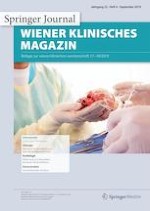Anzeige
09.04.2019 | Labormedizin
„Lab on a Chip“
Erschienen in: Wiener klinisches Magazin | Ausgabe 4/2019
Einloggen, um Zugang zu erhaltenZusammenfassung
Hintergrund
Durch die Miniaturisierung haben sich nicht nur in der Mikroelektronik neue Potenziale ergeben, auch in der Sensorik und Analytik ist durch die Mikrotechnik eine Revolution in Bewegung gekommen.
Entwicklungen
Die „Lab-on-a-chip“(LOC)-Technologie erlaubt, Laborprozesse vollständig und automatisiert in Kanälen, deren Größe im Mikrometerbereich liegen, durchzuführen. Die größte Herausforderung besteht darin, die Fertigungskosten trotz der Miniaturisierung und der anwendungsspezifischen Auslegung niedrig zu halten. Wird dies erreicht, kann man die medizinische Laboranalytik meist schneller und mit weniger Personalaufwand durchführen. So ist zu erklären, dass LOC bereits in viele Laborgeräte integriert wurde und aus dem „point-of-care testing“ (POCT) nicht mehr wegzudenken ist. Durch neue Marker, wie bei der Flüssigbiopsie, und Messtechniken, wie die Raman-Spektroskopie und Massenspektrometrie, entstehen weitere Potenziale, die es erlauben werden, schnellere und spezifischere laboranalytische Aussagen auf Basis der LOC-Technologie zu machen.
Schlussfolgerungen
Die LOC-Technologie hat das Potenzial, die medizinische Praxis zu verändern, insbesondere in Fällen, in denen das zentrale Labor nicht verfügbar ist oder nicht schnell genug Ergebnisse liefern kann.
